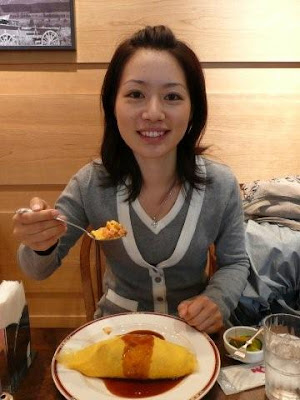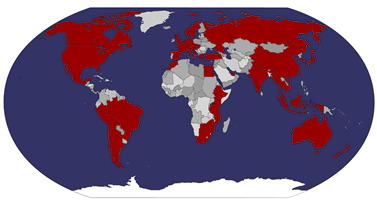Arriving in Japan, I convert my rail pass and head back to Fukuoka, dump bags in Toyoko Inn, then hop on the next train down to Kumamoto. Here there's a pretty castle to visit, along with one of Japan's Three Best Gardens (Japanese Love creating Best 3 Lists). The MOS pulls me in before I've escaped the station, but I walk it off and pop in to the Kumamoto Art Museum on the way, where there is a lovely exhibition about Japanese Modern Painting from the Eisei-Bunko Era. Unfortunately photography wasn't allowed and there was no catalogue, otherwise I probably would have bought it.
Kumamoto-jo
Next the impressive Kumamoto Castle, which is one of Japan's 3 most famous castles (remember what I said about 3s).

The real thing

And how the Japanese people see it
Construction began in 1601 and features unique very steep stone walls called mushageishi that are almost impossible to scale.

The main castle building is 6 stories high , about 30m above the stone wall. It performed particularly well in the Seinan Civil War, when they held out against a sustained siege in 1877. Even some of its lookout towers, especially Uto-Yagura and Iidamaru are multi-story and awe-inspiring in their own right.

One of the walls surrounding the castle, Naga-Bei, (The Long Wall) is 242m long. The inside of the castle houses a museum.

Pillow apparently

For this hard man
And finally Suizenji Jojuen Garden was built as a villa residence for a feudal lord.

It's a park with lots of water flowing about, but feature I find especially interesting is that the walk around it is designed to follow the Tokaido traditional route from Tokyo down the country (that the bullet trains now speed along). So as one walks around the garden, one passes a Fuji mound, and other hills that map to real features on the road to Kyoto and beyond.


Heron

Fuji
In the evening I met Akane-chan, who lets slip mid evening that Jose proposed to her whilst over her! Yay! Congratulations! We enjoy skewers of meat and beer (or tea in her case) to celebrate!

Next morning I have the train marathon… From Hakata to Osaka, meet Mariko for lunch

Cully and Omerrette
The back on the train to Tokyo, to meet Eri-berry (which doesn't happen 'cos the dappy girl has left her mobile at home), then Tokyo to Hachinohe, then on to Aomori. Approximate distance? About 2000km! This would not be do-able with UK trains! But in Japan, no problem - start at 9am and even with several hours out, you'll still be in bed by 11pm! When I've got a spare minute (okay it'll never happen), I'll have to work out the exact distance and time to see what my average speed was over the day. I think on the order of 200-250km/hr!

Double decker bullet trains!
The Holy Trinity of Baths
So why have I come so far? If you can imagine Japan as the four islands looking a bit like a dragon - I'm now at the top of the body. Incidentally, when they build the tunnel between the main island, Honshu, and the "head", Hokkaido, effectively cutting the throat of the dragon, there were lots of mysterious deaths, and people at the time attributed this to humans interfering by being somewhere they oughtn't be. Anyway, there are over 2,000 onsen in Japan, from the frozen north to the tropical south. Tohoku, however, is home to the holy trinity of Japan's bathing culture:
Zao (Yamagata prefecture), 40 minutes by bus from Yamagata train station, is an Alpine-style village with an almost all Zen calm about it, famous for the azure waters of its rustic dai-rotemburo (trio of outdoor pools).
Naruko (Miyagi prefecture) is known for its medicinal hot springs research facility and its crowning glory, Taki-no-yu, a fabulously atmospheric wooden bathhouse, which has hardly changed in 150 years. 40 mins from Furukawa Station
But, for the onsen cognoscenti, Aoni (Aomori prefecture) makes for both the most atmospheric and isolated bathing in the north, with its time-warp oil lamps replacing electricity. It's a simple place, close to nature, with thermal waters containing a hint of radium.
So basically I want to visit all three of these, though in the time I have, one or two will do.
Does the JR Rail Pass save much money in Japan?

I'm here for 4 days. Now admittedly I'm packing it in, but here's what I'm up to, and how much the train would cost:
Arrive Shimonoseki
Shimonoseki - Hakata 10UKP (from memory when I had to buy it last time!)
Hakata - Kumamoto - return 30UKP
Hakata - Osaka 65UKP
Local journeys around Osaka - 5UKP
Osaka - Tokyo 67UKP
Tokyo - Aomori - 70UKP
Aomori - Hagasaki - return 10UKP
Aomori - Fukukawa 50UKP
Fukukawa - Naruko - return 10UKP
Fukukawa - Tokyo - 50UKP
Local journeys around Tokyo - 10UKP
Narita Express - 14UKP
Total value (estimated approx) 400UKP
All this for a pass costing 110UKP!! Don't ever come to Japan without one! You will regret it!
Not the Aoni Onsen!
I'm sitting on the train next to the toilet in a carriage full of women with no bladder control.
Today I tried to go to Aoni onsen. Unfortunately I caught the wrong train, which wasted several hours, and so ended up going to Nuruyu Baths instead. I may be the first Westerner to go there. I certainly was of much interest naked to the other men. It wasn't a gay joint before you ask. The baths were called Tsuru No Yu, or Crane Hot Springs, and were a twenty minute bus ride away from Kuroishi Station, itself a 45 minute (private) train ride from Hakasaki station, itself an hour by train from Aomori, whence I set off this morning at 8am. Aoni is supposed to be one of the holy trinity of northern onsen, but they are seriously remote, hence the early start. With all the time wasted by hopping on the wrong train (exactly the right time, wrong company), it was too far to go without staying overnight. Not in itself an issue, but I have a reservation elsewhere.

In Japan everything is considered
Anyway, I was helped to sort out the alternative option by a very nice lady who was travelling with her husband to another onsen. They are onsen maniacs, and have visited over 100 all over Japan! Respect! They dropped me and pointed to a sign, saying the baths were here. They weren't, this was the car park. After trying all the houses surrounding the car park, disturbing an elderly lady from her siesta, I decided to wander the seemingly deserted village and find someone else to ask. Eventually I was pointed, then finally handheld, up to the baths. Pays my money, goes in, and discover that they do not provide towels, or soap, or shampoo. Ah.

So I take my seat on one of the little plastic seats under the showers, and rinse away. The idea in Japanese baths is that you wash yourself thoroughly before heading into the shared big pool. This I would not be able to do properly today. Anyway, a full rinsing later, I potter over to one of the two pools. By accident I choose the hot one first. It's no disgrace in onsen to yelp as you slide into the scalding water, which I almost do. In and soak away all that dirt that I wasn't able to soap off! That'll teach you lot to not provide washing materials! Back and forth between the pools and the showers a couple of times, and I've had enough. Now to.. err.. dry myself.

There's nothing to be done but a general rubbing of water off. It doesn't work very well. For those of you who have seen photos of me recently, you will know that my hair resembles a mop. It functions as one too. I decide I'll have to use my Rohan jumper as a towel. It doesn't work especially well, but does get me to the point where I'm only "quite" wet and therefore can throw the rest of my clothes on and let them soak up the excess. Messy. I leave the changing area and head out to the relaxing space, sit cross-legged on the tatami mats, and let my body heat dry my clothes. The jumper is sodden, so I don't even try with that.
Still a while till the bus back, so I walk around town, buying some beef udon noodles which an old lady heats up on my request. Unfortunately I ask for little hot, which she takes very literally, as I find out when I eat the off-cold noodles looking down over the river and cemetary. Training it back, I enjoy a Yebisu malt with some japanese nuts. It's interesting that there are so many private railways in Japan. How does the funding work? Why are there not private lines in the UK? Perhaps something like the Heathrow Express counts as one. Presumably they make a profit here otherwise why would the firms be running them? Unlike HEx, these are not expensive. JR (Japan Railways) is the state railway company here, but in almost all towns and cities there are private lines or even networks. I wonder how a Whitstable - Canterbury railway would fare back home.
Not the Naruko Onsen!
Cough, not doing very well with onsens. Stayed the night in Furukawa, but unfortunately Alastair drops the bomb-shell on me… the Grand Sumo tournament is on in Tokyo at the moment! This means the only way I would get to the onsen (and get down for sumo) is by taking the 06:05 train. It's just not happening. To my credit, I try. My toes make it out from under the duvet at least twice. Anyway, shinkansen down to Tokyo, couple of stops on the local trains - Akihabara, change Sobu, two stops and out at Ryougoku Station. Walking round I catch up with a fairly large chap waddling along in his yukata.

Beefcake

Reminds me of that photo of me with Chris Fisher

And in…
Inside I'm up in the heavens with a cheap seat - 3600Y, or about 16UKP. There are boxes available for about 200UKP! It's a good atmosphere, with people coming and going, popping out for refreshments, and a mix of ages and sexes watching - even several girls on there own. The refreshments are beer, soft drinks, popcorn, hot dogs, and steamed buns. There seems to be some kind of betting system present, but even were I interested in participating, I can't work it out.

Flags outside of the stadium
So what's the format? The stadium is almost round, like a boxing ring, with large photos of the competitors or past champs lining the roof.

A wooden roof, which is supposed to represent a Shinto shrine, hangs over the stage with a large japanese flag above it. The raised ring itself has small steps leading up to it, no ropes or anything, hence competitors frequently crash out on to those sitting close by, especially the judges, of which there are five, dressed in black with a black cloth covering their cross-legged sitting position. Any controversial decisions they all step up, form a circle in the middle and debate.

The lead judge announces the decision over his microphone.

Pick up the match listings

Sumo has a long history in Japan
I decide it's appropriate to tie my hair "sumo style". I can't find an elastic band in my bag so have to use a BA First luggage tag, ahhh I'm a tart I know! So the competition is divided into an East vs West system, with half of the wrestlers on each side. Not sure whether they are allocated according to where they are from geographically. Then they all have rankings within two groups. The match chart tells you how many bouts they have won and lost in this competition, but today's only day 2 (of 15?), so it's either a single previous win or loss. Each day they play a different person, so presumably over the two weeks, they get to play everyone.
It's interesting that there is a vast difference between the size and experience of different wrestlers. Some have been in the top division for years, others are only on their second (top level) fight. Some are huge and immensely tall, others short and squat. There's a lot of fat about though, presumably with a fair bit of muscle buried underneath. Between the two hulks stands a ceremony master, or referee, all dressed in lovely colourful yukatas.
Fight!


So, the two competitors step up into the ring. They bow at each other, then go through some sort of warm up, involving lifting one leg then the other leg up as far as they can stretch, squatting, pottering about a bit. They clap. Then they squat down at the lines as if to fight. Generally then one will get up again and stretch, and they potter again. When they're almost ready, they go back to their corner, have a sip of water, throw some over their selves, quickly towel, and sometimes throw some salt into the ring (symbolic - salt is purity, maybe?). Then it's time.

I decide to adopt a sumo cut
Crouching opposite each other, they spring up. These guys weigh 150kg, more.. So this is a lot of body crashing into body. The technique seems to be to launch yourself at your opponent as hard as can be to destabilise him, then slap him around the face like a little girl as he topples backwards out of the ring. Sometimes they get stuck in locks where official needs to reach between them to tighten their pants (don't ask!), then he slaps them both on the backside and they continue. All very interesting. If either competitor is thrown out of the ring or hits the floor, they lose and it's over.

The winner gets to stay in the ring and squat for a second, whilst the losers are straight out. Several more competitors hop and shake about in the tunnels, warming up before coming out. The wrestlers about to come on sit on cushions by the side of the ring. I get the impression that there's a lot more going on, but this is my ill-informed understanding. I do get a bit more because of NHK, the Japanese TV station, broadcasting an English commentary on FM radio, which I pick up.
Im between fights, occasionally there are ceremonial things happening. Sometimes all the wresters troop out, stand in a ring on the stage, raise their arms and generally demonstrate a show of force, the troop off again.


East and West separately, as, if nothing else, there wouldn't be room for them all out together. When they do this, they wear a kind of dress, all of which are different and beautiful patterns, very colourful. There is also a moment when one of the more senior wrestlers does a special dance thing.

No idea what it means. Google.com&search=wiki+sumo search please!
Anyway, what a marvellous experience! Sumo was one of the two things I still had left on my list for Japan. The other is eating fugu, the potentially poisonous pufferfis whih apparently is fairly bland and tasteless. Anyway, got the sumo done, I can leave Japan happy.

The pufferfish (fugu) that got away…

Sayonara Eri-berry and..
Sayonara Japan!




No comments:
Post a Comment